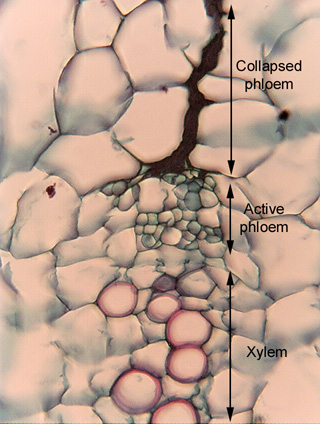 Fig.
8.3-2a. Transverse section of phloem in a cactus
(Melocactus peruvianus; native to Peru, common name is Turk’s cap
cactus). Sieve tube members and companion cells typically function for only a
few weeks or months, then are replaced by new cells. Cacti often have a
surprisingly small amount of active phloem at any time but even small plants
only a few years old may have large amounts of collapsed, non-functional phloem
from previous years. The
dark, black strip of collapsed phloem here shows that the cells collapse down to
the point that individual cells cannot be distinguished, even at high
magnification. Actually, the collapsed phloem typically looks like
nothing more than a featureless smudge even in electron micrographs.
Fig.
8.3-2a. Transverse section of phloem in a cactus
(Melocactus peruvianus; native to Peru, common name is Turk’s cap
cactus). Sieve tube members and companion cells typically function for only a
few weeks or months, then are replaced by new cells. Cacti often have a
surprisingly small amount of active phloem at any time but even small plants
only a few years old may have large amounts of collapsed, non-functional phloem
from previous years. The
dark, black strip of collapsed phloem here shows that the cells collapse down to
the point that individual cells cannot be distinguished, even at high
magnification. Actually, the collapsed phloem typically looks like
nothing more than a featureless smudge even in electron micrographs.
The collapsed phloem of this plant extended far above the top of the micrograph. Considering how much volume the cells lose as they collapse, the dark strip of collapsed phloem must represent thousands of defunct sieve tube members and companion cells. Furthermore, considering that this plant is only a few years old, there must be a production and collapse of hundreds of sieve tube members every year. But from this micrograph, it appears that at any particular time, there are only a few active cells; consequently, each must function for only a few weeks before collapse, maybe only for a few days.